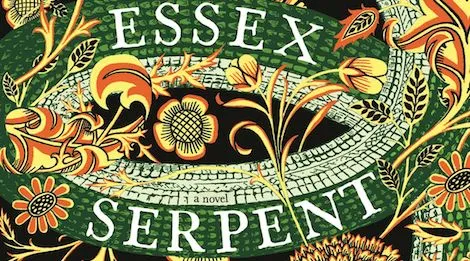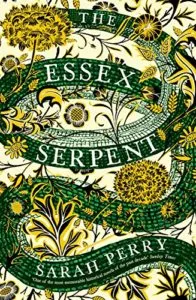
THE ESSEX SERPENT is a Study in Victorian Values
This content contains affiliate links. When you buy through these links, we may earn an affiliate commission.
 Sarah Perry’s novel The Essex Serpent is a beautifully written, complex novel that immerses the reader in the atmosphere and prejudices of Victorian, rural England. Cora Seaborne is a young widow whose husband, Michael, has recently died of cancer. Contemporary readers will recognize Michael as abusive, but Cora never explicitly acknowledges that. After his death, she feels conflicted but relieved and befriends Luke Garrett, the doctor who treated her husband, and William Ransome, an Anglican minister.
The novel skillfully conveys the complexities of relationships, including platonic friendships and unrequited romantic attraction. Some historical fiction books have anachronistic characters that seem progressive enough for the 21st century; others make all their characters equally prejudiced. Perry avoids both extremes. Ransome is inquisitive and less sexist than the other male characters.
The town is filled with rumors of a mysterious beast called the Essex Serpent. Whenever animals or people go missing, townspeople suspect that the beast has devoured it. Cora is an amateur fossil hunter in a time when words like dinosaur and paleontology are unknown. The idea of a woman searching for fossils—or ammonites, as the Victorians call them—is scandalous.
The recent discovery of prehistoric fossils, as well as the publication of Darwin’s On the Origin of Species, divides the town. Many people see these scientific advancements as threats to religion, while Cora and William are more open-minded. William’s teenage daughter, Joanna, makes up a pagan ritual to perform with a friend. Even within a small town, Victorians’ beliefs were not monolithic, the novel suggests.
Technically, The Essex Serpent is an epistolary novel, although it isn’t composed entirely of characters’ letters. Frequent letters help develop characters’ personalities and relationships. Structurally, they also break up dense chapters.
Although all of the characters are multifaceted, disability representation is one of the book’s least successful aspects. Dr. Garrett, a brilliant surgeon, has dwarfism. He’s infatuated with Cora, who treats him condescendingly to his face. Although she considers him a friend, she nicknames him “the Imp,” as if he’s some kind of inhuman, mythical creature. Ableism, like racism and sexism, is apparent in the characters’ attitudes but never named. This makes their worldview consistent. However, a man with a disability or other congenital condition, in unrequited love with an able-bodied, average-height woman, is a common trope.
It’s possible to interpret Cora’s preteen son, Francis, as autistic. Of course, the characters would be unaware of autism, so this is merely a theory. He often seems withdrawn, especially with strangers, and has a wide range of intense interests. He befriends Stella, William Ransome’s wife, and corresponds with her often via letters.
Although some characters have stereotypical traits, for the most part, they’re all complex, fascinating individuals. Like the Victorian novels that it emulates, The Essex Serpent focuses more on character and setting than plot. It’s a rewarding read that vividly evokes the physical landscape and attitudes of Victorian England.
If you enjoyed The Essex Serpent, particularly Cora’s search for fossils, I recommend Remarkable Creatures by Tracy Chevalier. Remarkable Creatures is a novel about Mary Anning, who discovered dinosaur fossils on the coast of England in 1810. Women could be ostracized for doing this traditionally masculine work. Like in Perry’s novel, these discoveries were controversial because they challenged some people’s religious beliefs about the creation of the Earth.
Sarah Perry’s novel The Essex Serpent is a beautifully written, complex novel that immerses the reader in the atmosphere and prejudices of Victorian, rural England. Cora Seaborne is a young widow whose husband, Michael, has recently died of cancer. Contemporary readers will recognize Michael as abusive, but Cora never explicitly acknowledges that. After his death, she feels conflicted but relieved and befriends Luke Garrett, the doctor who treated her husband, and William Ransome, an Anglican minister.
The novel skillfully conveys the complexities of relationships, including platonic friendships and unrequited romantic attraction. Some historical fiction books have anachronistic characters that seem progressive enough for the 21st century; others make all their characters equally prejudiced. Perry avoids both extremes. Ransome is inquisitive and less sexist than the other male characters.
The town is filled with rumors of a mysterious beast called the Essex Serpent. Whenever animals or people go missing, townspeople suspect that the beast has devoured it. Cora is an amateur fossil hunter in a time when words like dinosaur and paleontology are unknown. The idea of a woman searching for fossils—or ammonites, as the Victorians call them—is scandalous.
The recent discovery of prehistoric fossils, as well as the publication of Darwin’s On the Origin of Species, divides the town. Many people see these scientific advancements as threats to religion, while Cora and William are more open-minded. William’s teenage daughter, Joanna, makes up a pagan ritual to perform with a friend. Even within a small town, Victorians’ beliefs were not monolithic, the novel suggests.
Technically, The Essex Serpent is an epistolary novel, although it isn’t composed entirely of characters’ letters. Frequent letters help develop characters’ personalities and relationships. Structurally, they also break up dense chapters.
Although all of the characters are multifaceted, disability representation is one of the book’s least successful aspects. Dr. Garrett, a brilliant surgeon, has dwarfism. He’s infatuated with Cora, who treats him condescendingly to his face. Although she considers him a friend, she nicknames him “the Imp,” as if he’s some kind of inhuman, mythical creature. Ableism, like racism and sexism, is apparent in the characters’ attitudes but never named. This makes their worldview consistent. However, a man with a disability or other congenital condition, in unrequited love with an able-bodied, average-height woman, is a common trope.
It’s possible to interpret Cora’s preteen son, Francis, as autistic. Of course, the characters would be unaware of autism, so this is merely a theory. He often seems withdrawn, especially with strangers, and has a wide range of intense interests. He befriends Stella, William Ransome’s wife, and corresponds with her often via letters.
Although some characters have stereotypical traits, for the most part, they’re all complex, fascinating individuals. Like the Victorian novels that it emulates, The Essex Serpent focuses more on character and setting than plot. It’s a rewarding read that vividly evokes the physical landscape and attitudes of Victorian England.
If you enjoyed The Essex Serpent, particularly Cora’s search for fossils, I recommend Remarkable Creatures by Tracy Chevalier. Remarkable Creatures is a novel about Mary Anning, who discovered dinosaur fossils on the coast of England in 1810. Women could be ostracized for doing this traditionally masculine work. Like in Perry’s novel, these discoveries were controversial because they challenged some people’s religious beliefs about the creation of the Earth.
____________________
You may also like these excellent British reads and books about the women featured in Lumberjanes. 











